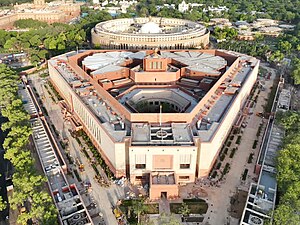
Back برلمان الهند Arabic Parllamentu d'India AST Hindistan Parlamenti Azerbaijani भारत के संसद Bihari ভারতীয় সংসদ Bengali/Bangla Parlament de l'Índia Catalan Parlament Indie Czech Senedd India Welsh Indisches Parlament German Ινδικό Κοινοβούλιο Greek
28°37′2″N 77°12′29″E / 28.61722°N 77.20806°E The Parliament of India or Indian Parliament, (ISO: Bhāratīya Saṁsada) is the supreme legislative body of the Republic of India. It is a bicameral legislature composed of the Rajya Sabha (Council of States) and the Lok Sabha (House of the People). The president of the Republic of India, in their role as head of the legislature, has full powers to summon and prorogue either house of Parliament or to dissolve the Lok Sabha, but they can exercise these powers only upon the advice of the prime minister and the Union Council of Ministers.
Those elected or nominated (by the president) to either house of the Parliament are referred to as members of Parliament (MPs). The members of parliament in the Lok Sabha are directly elected by the voting of Indian citizens in single-member districts and the members of parliament in the Rajya Sabha are elected by the members of all state legislative assemblies by proportional representation. The Parliament has a sanctioned strength of 543 in the Lok Sabha and 245 in the Rajya Sabha including 12 nominees from the expertise of different fields of literature, art, science, and social service.[4] The Parliament meets at Sansad Bhavan in New Delhi. The Parliament of India represents the largest democratic electorate in the world (the second being the European Parliament), with an electorate of 968 million eligible voters in 2024. On 28 May 2023, Prime Minister Narendra Modi, unveiled and inaugurated the New Parliament Building (Sansad Bhavan), located adjacent to the previous one.
- ^ "Droupadi Murmu takes oath as the 15th President of India". The Hindu. New Delhi, India. 25 July 2022. Archived from the original on 25 July 2022. Retrieved 25 July 2022.
- ^ "Jagdeep Dhankhar sworn in as 14th Vice-President of India". The Times of India. Mumbai, India. 11 August 2022. Archived from the original on 14 August 2022. Retrieved 13 August 2022.
- ^ "Narendra Modi is sworn in as the 15th Prime Minister of India". The Times of India. 26 May 2014. Archived from the original on 6 September 2014. Retrieved 15 August 2014.
- ^ "Nominated Members of Rajya Sabha". Rajya Sabha. Archived from the original on 26 January 2022. Retrieved 26 January 2022.




